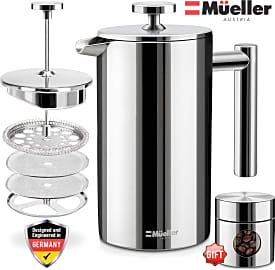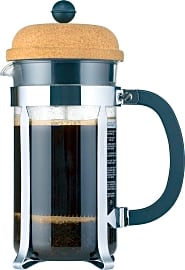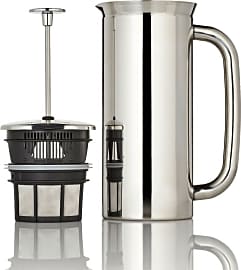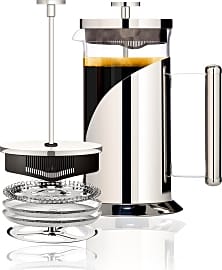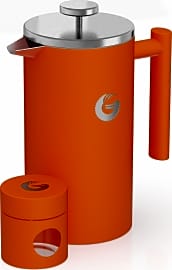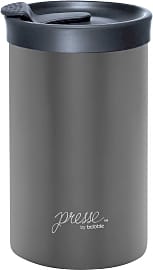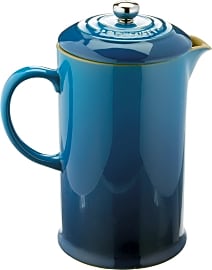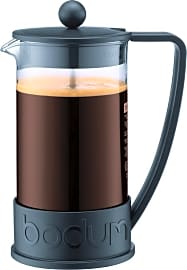The 10 Best French Presses

This wiki has been updated 41 times since it was first published in March of 2015. Many coffee connoisseurs will tell you that a French press is one of the best and simplest ways to enjoy a fresh and full-bodied drink. The filtering system can also transform your preferred blend of tea leaves into a perfectly brewed cuppa. Our selection features a range of sizes, designs, and colors, so you can find just the right fit for your caffeine fix and decor. When users buy our independently chosen editorial selections, we may earn commissions to help fund the Wiki.
Editor's Notes
January 15, 2020:
There are a couple of classic options that stand out when it comes to French presses, including the Frieling Double Wall and Bodum Chambord. The coffee these make will please even the most discerning of drinkers, but they aren't hard to use, so they're also appropriate for those who take a more casual approach to coffee preparation. We've kept the Espro Vacuum Insulated, as well, even though it has two small drawbacks: one, it's quite pricey, and two, the last bit of drinkable coffee can be hard to pour, as it becomes trapped in the bottom of the vessel. On the plus side, it doesn't leak grounds into your drink, nor does it produce a bitter beverage, no matter the type of coffee beans you prefer. And, finally, with some consideration, we have opted to keep the piece from Le Creuset Stoneware. It is truly an eye-catching choice, but it's on the more delicate side, and the screen it arrives with isn't fantastic. This makes it better for those who want a decorative piece that will make a cup of coffee from time to time, rather than for those java junkies who are persnickety about their daily brew.
Special Honors
Palmpress Coffee Press The Palmpress Coffee Press is a nifty little device that expands and collapses for ultimate portability, although its relatively small size does equal a cup of coffee that's on the small side, too. Nevertheless, it's an excellent choice for travel or carrying to and from work, especially since it's a cinch to clean. palmpress.coffee
An Impressive Cup Of Coffee
These are the folks who brew different strains of bean at different water temperatures and store their coffee in underground, sound-proof vaults.
A strange dichotomy has taken hold of coffee culture in the past 20 years. Places like Starbucks and its most direct competitors offer up a litany of caffeinated drinks presumably derived from coffee beans. Most consumers order them in forms so far removed from actual coffee by the addition of sugar, creamers, flavorings, and spices that to call the drinks coffee would be a kind of deception.
Then, there is the opposite end of the coffee-lover spectrum, which was, perhaps, a knee jerk reaction to the gourmand approach taken up by the big java retailers. I'm talking about the in-group of gourmet coffee enthusiasts, the specialists, the aficionados. These are the folks who brew different strains of bean at different water temperatures and store their coffee in underground, sound-proof vaults.
That's not to say the coffee purists out there necessarily know what they're talking about. Honestly, you could get a large enough group of people together and if they all agree on the superiority of the characteristics of one glass of water over another you could capitalize on a craze over gourmet boutique artisan water in no time.
One thing that's pretty undeniable, however, whether you're a purist or a casual coffee drinker, is that the way you choose to brew your coffee has a distinct effect on its flavor and its strength. When you use a French press, specifically, you're liable to end up with a stronger, more flavorful cup of coffee from the same amount of water and beans as you would in a regular drip coffee maker.
For Molecular Motion, Materials Matter
Coffee, unlike revenge, is a dish best served hot. I would argue that hot revenge has its good points, as well, but the point is that coffee just tastes better hot. That's because our human taste receptors don't respond with as much specificity when we consume foods at or above 98˚F. Beyond that point, we taste less and less, so that piping hot cup of coffee just tastes less bitter. The same is true below a certain temperature, as well, for all you iced coffee drinkers out there.
That means you want to find a French press that, among other things, comes in a material that will best insulate your joe against the cold. Understanding how coffee gets cold in the first place ought to help with your decision.
Ceramics come in a close second, with metal pulling up the rear.
The thermal conductivity of a material is what will determine its ability to keep a hot beverage hot. Hot coffee is hot because its molecules move so quickly. As they slam into the sides of a container, they transfer a certain amount of energy to the container wall, slowing them down and cooling off your drink.
For clarity, imagine that you were in a mattress shop, and your sole purpose was to find the mattress that was the most fun for jumping and bouncing. If you jumped on a particularly hard mattress, your legs would get tired and your disappointment would ultimately grind your fun to a halt. If, however, you found yourself a wonderfully springy mattress, the sheer joy of the bounce could keep you airborne for hours. You want to choose a material for your coffee that's best for bouncing.
This is where the purists will come in and berate me for suggesting that you brew a full French press and leave the unconsumed portion behind until you're ready to drink it. They'll tell you that you're ruining the remaining coffee by over-brewing it. Technically, they'd be right; your coffee will increase in strength and bitterness the longer you leave it in the press, even after you press it. But if we're speaking in realities here, then that is most certainly what you will do. Either way, if you only have your coffee in there for the five minutes it takes to brew, you want it coming out as hot as it went in.
As far as the bounciness of your materials goes, glass is best, as it doesn't have a crystalline surface to it like metal or ceramic, so it gets the highest bounce rating. Ceramics come in a close second, with metal pulling up the rear. Take a look at the sizes of the available presses on our list, and match up the right amount of coffee for your household with the best available bounce, and the heat will hang around.
A Building Brouhaha
Before the French press as we know it today came about–with its metal mesh screens and elongated press arm–European coffee drinkers used cheesecloth screens fitted to somewhat similar metal rods for their brewing purposes. It wasn't until 1929 that a Milanese designer named Attilio Calimani patented a press we would categorize with its modern brethren.
Another Italian, Faliero Bondanini, began producing a similar device out of a French clarinet factory in 1958, and it quickly caught on in that nation, despite essentially being an Italian invention. Aided in part by its use in the 1965 British espionage thriller The Ipcress File, the device's popularity spread throughout Europe, eventually making its way to the US.
Since the coffee purists came along and started making us all feel bad about how we drink our coffee, presses have gotten even more popular stateside, so much so that companies like Starbucks have created single-serve travel presses like the one on our list.


